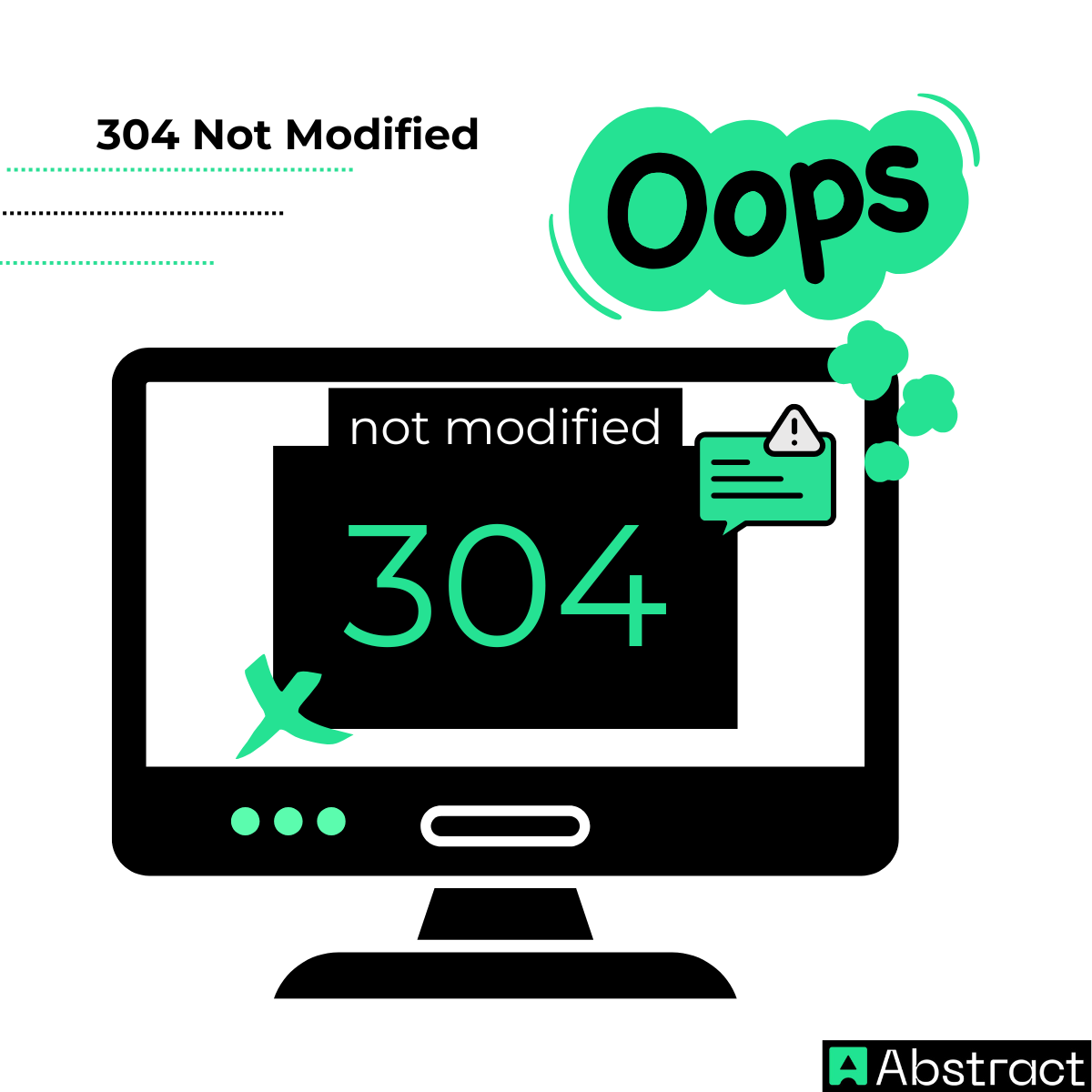
The HTTP Status 304 indicates that the requested resource has not been modified since the version specified by the request headers If-Modified-Since or If-None-Match.
What is HTTP Status Code 304? 🚀
The HTTP 304 Not Modified status code is one of those subtle yet powerful tools that web developers use to enhance performance, minimize network usage, and streamline data flow between clients and servers.

At its core, 304 is the web’s way of saying: “Nothing has changed—you can stick with the version you’ve already got.” No need to resend the data, no unnecessary processing. This small response code plays a big role in web optimization, and understanding how it works can give your applications a serious performance boost.
In this article, we'll explore how the 304 code operates under the hood, why it matters for performance, and how the principle behind it ties into best practices when working with APIs—especially in contexts like those served by AbstractAPI.
How Does an HTTP 304 Response Work?
To fully grasp the significance of the 304 Not Modified status, it helps to understand how conditional requests work within the HTTP protocol. Here’s a step-by-step breakdown of a typical interaction:

📌 Step 1: Initial Request
A client—let’s say your browser or a frontend app—makes its first request to a server for a specific resource, such as data from an API endpoint or a static image.
📥 Step 2: Response with ETag or Last-Modified
The server replies with a 200 OK status and includes the resource in the response. It also adds a metadata header, typically an ETag (Entity Tag) or a Last-Modified timestamp.
- The ETag is a unique identifier or fingerprint that represents the current version of the resource.
- The Last-Modified header provides the date and time the resource was last changed.
💾 Step 3: Client Stores the Data
The client caches the data locally and keeps track of the associated ETag or Last-Modified value.
🔁 Step 4: Conditional Follow-Up Request
Later, when the client needs the same resource again, it doesn’t blindly request everything. Instead, it sends a conditional GET request, using either:
- If-None-Match: <ETag>
- or If-Modified-Since: <timestamp>
This is essentially the client asking:
- “Hey server, has this file changed since I last checked?”
✅ Step 5: Server Response
Now two things can happen:
- If the server sees that the resource has not changed, it sends back a 304 Not Modified response with no body.
- If the resource has been updated, it responds with 200 OK and the fresh data.
This efficient dialogue ensures that only modified resources get re-downloaded, drastically cutting down on bandwidth usage and processing time. ⚡
Why is the 304 Status Code Important?🧠
The 304 Not Modified status code might seem minor on the surface, but it plays a critical role in optimizing web performance and reducing resource consumption. Let’s dive deeper into why it matters:
🌐 1. Saves Bandwidth
One of the most immediate and tangible benefits of a 304 response is that it avoids sending the full content of a resource again if it hasn't changed. Instead of retransmitting an entire JSON payload, image, stylesheet, or HTML document, the server simply tells the client, "You already have the latest version—use that."
Why this matters:
- For users on limited or metered connections (such as mobile data), it reduces data usage significantly.
- On a large scale, for applications serving thousands or millions of requests per day, skipping redundant data transfer can result in massive reductions in bandwidth costs.
- It also contributes to a lighter network footprint, which is beneficial for hosting providers and aligns with sustainable computing practices.
Example:
- A dashboard web app that fetches user settings on every load could skip re-downloading this data if it hasn’t changed. With 304 responses, that daily user check-in becomes ultra-lightweight.
🚀 2. Improves Application Performance
The less data you need to download, the faster your app can respond to user interactions. By eliminating unnecessary resource transfers, 304 responses allow your app to rely on fast, local cache access.
How this boosts speed:
- Local storage (cache) is faster than network retrieval, even under the best conditions.
- Pages load quicker because the browser doesn’t have to wait for bulky data transfers to complete.
- On slow networks (e.g., 3G or congested Wi-Fi), avoiding even small downloads can shave seconds off perceived load time.
This is especially powerful for Single Page Applications (SPAs) and Progressive Web Apps (PWAs), where performance is crucial to retaining users and delivering a seamless experience.
Example:
- Imagine a weather app where location-based forecasts update hourly. If the user checks again within a few minutes, a 304 response ensures the UI updates instantly using cached data—no lag, no wait.
🧰 3. Reduces Server Load
From the server's perspective, processing fewer requests for full data means less work. If a client asks for a resource and includes an ETag, the server only needs to compare the tag—not generate or transmit the full resource.
Server-side benefits:
- Lower CPU and memory usage—the server avoids data serialization, rendering, or database lookups for unchanged resources.
- Faster response times—servers can respond to conditional requests almost instantly.
- Scalability improves—servers under heavy load can maintain responsiveness by minimizing resource-intensive operations.
For APIs in particular, this means developers can serve more clients with the same infrastructure, improving reliability during traffic spikes.
Example:
- An API that returns product catalog data might normally query a database and build a complex response. But with 304 handling, it just confirms the version hasn't changed and skips the heavy lifting entirely.
🔄 4. Encourages Smarter Caching Strategies
The 304 mechanism incentivizes developers to think intentionally about caching, versioning, and data freshness. It's not just about performance—it's about building more intelligent, sustainable applications.
Strategic advantages:
- Developers can design apps that proactively cache responses and update only when necessary.
- It enables fine-grained control over how frequently clients should request updates.
- Reduces the likelihood of bugs or performance issues caused by stale or out-of-date data.
By leveraging caching headers like ETag and Last-Modified, teams can balance freshness and performance according to their application's specific needs.
Example:
- A news reader app might use ETags to determine if new articles are available since the user’s last session. This reduces load while still ensuring up-to-date content.
🔐 5. Contributes to Secure, Predictable APIs
While the 304 response is often seen through a performance lens, it also helps with predictability and stability in client-server communication.
Hidden benefits:
- It allows clients to confirm data integrity without fetching the entire dataset.
- Ensures that intermediate caches (like CDNs or proxies) can serve valid content efficiently.
- By avoiding unnecessary data exposure, it can slightly reduce surface area for certain types of attacks (e.g., large response payloads triggering unwanted behavior).
In well-designed APIs, handling conditional requests gracefully reflects maturity and adherence to RESTful principles—making them more robust and developer-friendly.
- In short, the 304 status code is more than a technical nicety—it’s a powerful tool for creating faster, smarter, and more efficient web applications. When used properly, it enhances both client-side performance and server-side scalability, making it a best practice every developer should implement.
Conditional Requests and AbstractAPI 🔗
While many of AbstractAPI’s services are designed to return real-time, dynamic data—think live email validation or IP geolocation—the principle of conditional requests still applies as a best practice in API design.
Let’s imagine a scenario:
- Suppose you're using an AbstractAPI endpoint that provides relatively stable or infrequently updated data—like a list of country codes, supported languages, or configuration metadata for your app.
Here’s how conditional requests could enhance performance:
- On the first call, your application caches the response and stores the ETag.
- For future requests, it includes the If-None-Match header with the saved ETag.
- If the data hasn't changed, AbstractAPI could reply with 304 Not Modified, signaling that your cached version is still valid.
This simple check can optimize your app’s performance, reduce API usage, and lower your monthly data transfer costs—a win-win-win.
✅ Pro tip: Implementing this kind of logic isn’t just about optimization—it’s a sign of a well-architected client. Apps that make efficient use of API services scale better and provide a smoother user experience.
Conclusion: Why Every Developer Should Know 304🧾
The HTTP 304 Not Modified status code is a small response with a massive impact. It plays a key role in reducing unnecessary network traffic, speeding up application performance, and lightening server load—all while ensuring that data stays accurate and up to date.
Whether you're building high-traffic web apps, mobile clients, or working with third-party APIs, implementing conditional requests using 304 responses is a simple yet powerful best practice. It's especially effective when working with APIs like AbstractAPI, where efficiency and speed matter.

Understanding and applying the 304 status code isn’t just a performance trick—it’s a fundamental part of building scalable, responsive, and modern applications.
Want to explore more about HTTP status codes and how to make the most of them? Check out our HTTP status code guide to keep leveling up your API design skills.


